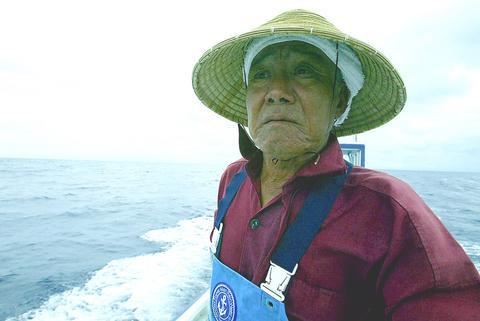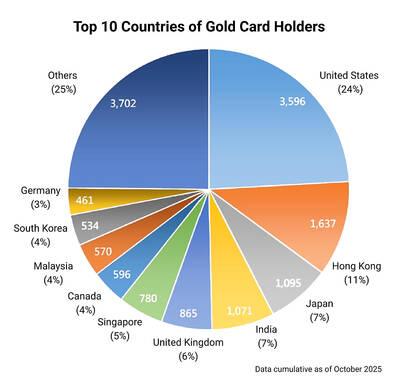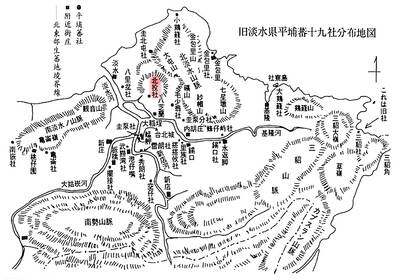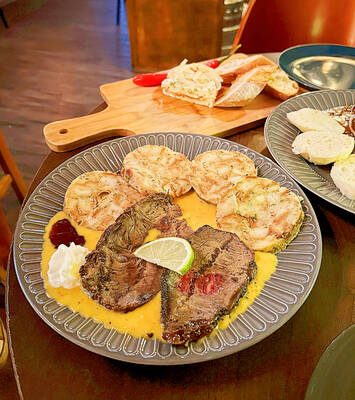The bonito with its large black back and silvery sides flopped aboard the fishing boat, scattering blood on the white deck. After reeling in a couple more, Hiroshi Fukumine, 74, pressed the throttle, and his boat began gaining speed, land receding into the distance.
Over the next hour, as warm waves crashed aboard and left big grains of salt on the skin, the boat roared into the East China Sea, with Fukumine's gaze fixed at a destination known only to himself. For on this morning, as on every other morning, the bonito were just bait for marlin.
Maybe today, as he had one day last year, he would catch a 500kg marlin, the biggest in a lifetime spent prowling the sea. His son, Hiroaki, 51, recently decided to succeed him, and the father spoke of retiring soon. His 74-year-old knees wobbled and his back ached. Age had changed his view of the sea.

PHOTO: NY TIMES
"Before, I was never afraid," he said later that day. "But as I've gotten older, I find myself fearing the waves. The sea can take your life."
Here on Japan's westernmost island, where Taiwan is visible on a clear day, four fishermen in their 70s continue to search the seas for the marlin that ends up on dinner tables across the nation. Born just as the commercial fishing of marlin began here in the 1930s, the old men, like the one in Hemingway's story, used to fish alone in skiffs.
Now the boats are bigger and have engines, but the fishing remains the same. The fishermen drag a bonito, attached to a hook and line, across the waters until a marlin bites, and then fight to reel in a fish that can weigh several times more than they do and that can swim at more than 70kph.
It is a contest the fishermen have often lost, sometimes fatally, before mechanized reels became popular here, about two decades ago.
Back then, once a marlin struck, the line would whip around as the fisherman scrambled to grasp it. Sometimes it would become entangled around his fingers or legs, and the marlin would yank him into the sea. In the most famous case, an 81-year-old named Shigeru Itokazu was killed in 1990 after a line became coiled around his thumb and a marlin pulled him into the sea, shortly after he had appeared as the subject of a documentary, The Old Man and the East China Sea.
A lean man, standing 165cm, Fukumine once had his middle-finger entangled in a line and ripped away by a marlin. A doctor here reattached the finger, but upside-down. He had it properly reattached in Ishigaki, a bigger island in Okinawa, and had missing flesh replaced from his backside.
After World War II, this island served as a focal point for a black-market trade between Japan and Taiwan, China and Hong Kong. Fukumine worked on boats that smuggled goods, like women's clothing, until the US occupying forces cracked down on the black-market trade in 1950. Then over the next two decades, he joined eight-man fishing boats that hauled in several marlin a day, before setting out aboard his own skiff.
Of the old men here, Fukumine is known for his boldness, in going out to stormy seas when others dare not to.
One day two decades ago, when waves were so high that no one else went out to sea, Fukumine did. Trying to reel in a fish, he fell overboard, as his boat moved on toward the island of Iriomote. He drifted for two hours and washed up against some rocks, where a search party found him despite mistaking him at first for a turtle.
These days, Fukumine tends to avoid such risks. So on a recent day when Taiwan became visible -- a sign that can mean, at this time of the year, that a typhoon is approaching -- he did not go out to sea. Instead, he spent the day drinking with fellow fishermen, untalkative at sea but voluble on land over drinks.
On this particular morning, with the waves settling down, he was back on the water, this time with his son. He had pushed so deep into the sea that Yonaguni's elongated silhouette, punctuated by its promontory, had vanished into the horizon.
Hours passed. Fukumine's face remained taut. Father and son rarely talked.
Then in the late afternoon, without saying a word, the son began reeling in the line, but without the urgency that would have suggested a big catch. The bonito had disappeared, as had the hook and part of the line. Only a shark could have swallowed it all, Fukumine said later.
Later that evening, after taking a bath, Fukumine sat alone in his living room. His son's wife had set bonito soup and other dishes on the table before him. He wore a relaxed countenance and a robe open at the chest, revealing an old man's shriveled skin. A support belt for his bad back lay next to him.
"When I don't catch marlin, even alcohol doesn't taste good," he said.
Fukumine spoke of bequeathing the boat to his son by year's end, and of retiring and getting a small one for himself. He was tired of talking, he told his visitors, but answered one more question about whether, after all these years, he loved the sea.
"The sea is beautiful," Fukumine said, then added, "The sea is my friend. It allows me to take fish."

Seven hundred job applications. One interview. Marco Mascaro arrived in Taiwan last year with a PhD in engineering physics and years of experience at a European research center. He thought his Gold Card would guarantee him a foothold in Taiwan’s job market. “It’s marketed as if Taiwan really needs you,” the 33-year-old Italian says. “The reality is that companies here don’t really need us.” The Employment Gold Card was designed to fix Taiwan’s labor shortage by offering foreign professionals a combined resident visa and open work permit valid for three years. But for many, like Mascaro, the welcome mat ends at the door. A

The Western media once again enthusiastically forwarded Beijing’s talking points on Japanese Prime Minister Sanae Takaichi’s comment two weeks ago that an attack by the People’s Republic of China (PRC) on Taiwan was an existential threat to Japan and would trigger Japanese military intervention in defense of Taiwan. The predictable reach for clickbait meant that a string of teachable moments was lost, “like tears in the rain.” Again. The Economist led the way, assigning the blame to the victim. “Takaichi Sanae was bound to rile China sooner rather than later,” the magazine asserted. It then explained: “Japan’s new prime minister is

NOV. 24 to NOV. 30 It wasn’t famine, disaster or war that drove the people of Soansai to flee their homeland, but a blanket-stealing demon. At least that’s how Poan Yu-pie (潘有秘), a resident of the Indigenous settlement of Kipatauw in what is today Taipei’s Beitou District (北投), told it to Japanese anthropologist Kanori Ino in 1897. Unable to sleep out of fear, the villagers built a raft large enough to fit everyone and set sail. They drifted for days before arriving at what is now Shenao Port (深奧) on Taiwan’s north coast,

Divadlo feels like your warm neighborhood slice of home — even if you’ve only ever spent a few days in Prague, like myself. A projector is screening retro animations by Czech director Karel Zeman, the shelves are lined with books and vinyl, and the owner will sit with you to share stories over a glass of pear brandy. The food is also fantastic, not just a new cultural experience but filled with nostalgia, recipes from home and laden with soul-warming carbs, perfect as the weather turns chilly. A Prague native, Kaio Picha has been in Taipei for 13 years and